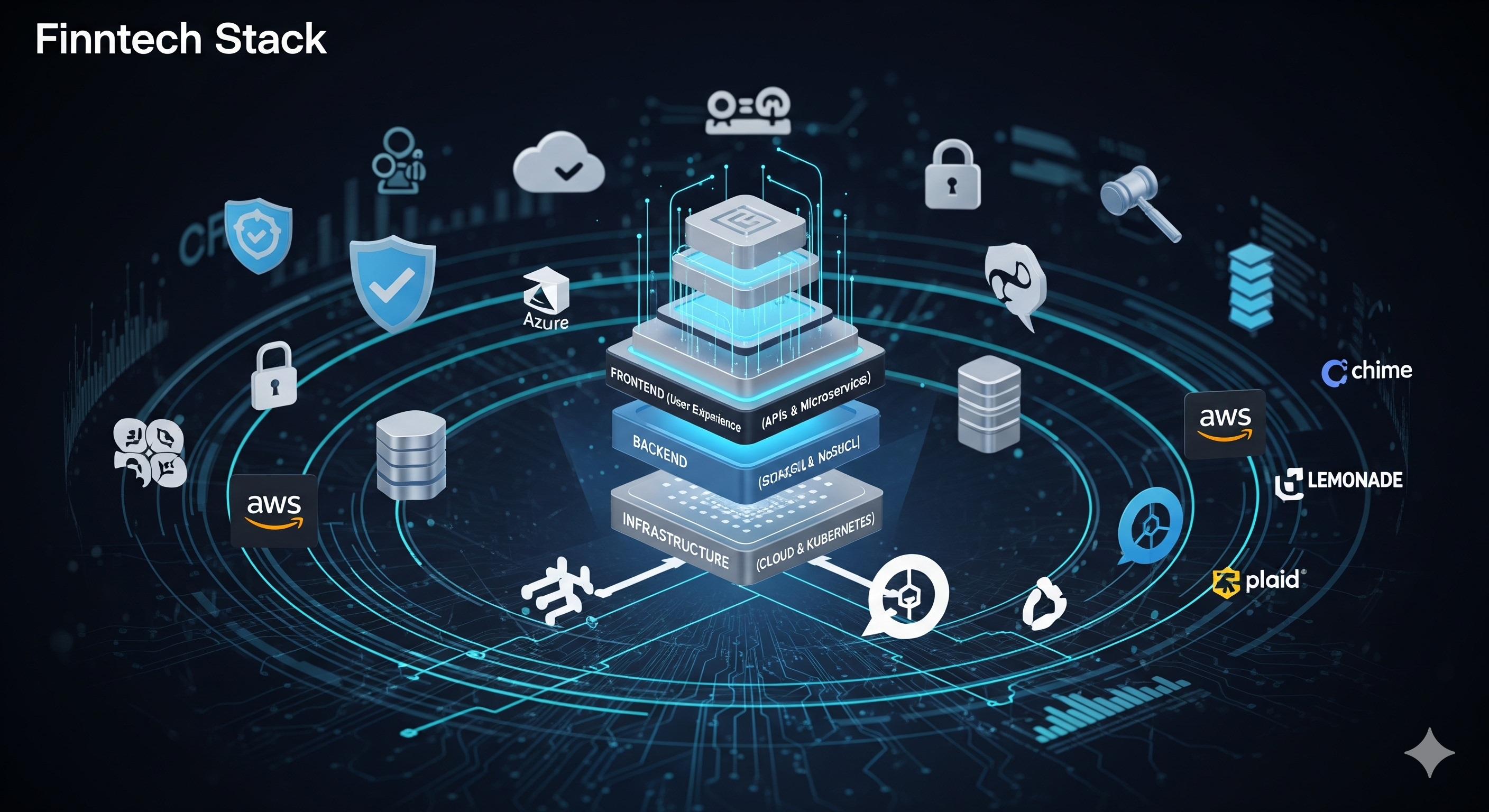The stakes for fintech and insurtech scale-ups have never been greater in 2025. Competition is intense, regulatory requirements keep changing, and consumers now demand instant, always-on digital experiences. Consequently, the tech stack you deploy can break or make you go fast, remain compliant, and please users.
Then, what does a future-proof fintech stack mean in 2025?
This post dissects optimal stack options, critical evaluation factors, and business case examples from companies such as Chime, Plaid, and Lemonade. If you’re refactoring legacy systems or building new ones, here’s what you should know.
Fintech tech stacks in 2025 are cloud-native, composable, and designed with compliance.
Node.js, Go, Python, and React are still top picks for performance and scalability.
Kubernetes, Terraform, and serverless architectures reign supreme in infrastructure choices.
Real-world examples illustrate the effect that smart stack choices have on product velocity and resilience.
Why Your Fintech Tech Stack Matters More Than Ever
Selecting the correct stack is no longer a technical choice—it’s a strategic one.
Speed-to-market is paramount to stay ahead in commoditized fintech verticals.
Compliance with SOC 2, PCI DSS, and GLBA is table stakes.
User expectations have been conditioned by Big Tech; latency or downtime is unacceptable.
Hiring and retention: elite engineers prefer to work with cutting-edge tools.
How can a subpar tech stack hold back fintech product velocity?
Legacy monoliths, tightly coupled services, or unstandardized infrastructure slow development cycles. Engineers devote more time to workarounds than innovation.
Key Criteria for Selecting a Fintech Tech Stack in 2025
1. Compliance-Ready by Design
If you’re developing a payments platform or an insurtech underwriting engine, you’ll probably require:
SOC 2 for trust and transparency
PCI DSS for processing payments
GLBA/HIPAA for privacy of data
Tech decisions can make or break your compliance process. Pick tools that:
Support logging that’s auditable (e.g., PostgreSQL + pgAudit)
Integrate with IAM tools (e.g., AWS IAM, HashiCorp Vault)
Provide prebuilt compliance frameworks (e.g., AWS Artifact, Azure Compliance Center)
2. Scalability & Modularity
Those monolithic days are over. Instead:
Microservices for loosely coupled feature sets
API-first development for quicker integrations
Containers and orchestration using Kubernetes for scaling
Real-world example: Plaid transitioned to a containerized architecture with Kubernetes to enhance scalability and deploy speed across services.
3. Engineering Velocity & Developer Happiness
Happy engineers ship faster. In 2025, this means:
Modern languages & frameworks: Node.js, Go, Python (Django/FastAPI), React
DevOps-friendly tooling: GitHub Actions, Terraform, ArgoCD
Excellent DX (Developer Experience): great CLI tools, integrated testing, clean documentation
Accelerate Your Fintech Engineering Roadmap
Balancing compliance, scalability, and velocity doesn’t have to be daunting. With the appropriate engineering partner, fintechs can reduce release cycles, hire the best developer talent, and remain audit-ready from day one.
Speak with our fintech engineering experts today
Best Tech Stack Pairings for Fintech Apps in 2025
Stack #1: The “Modern Cloud-Native” Stack
Frontend: React + TypeScript
Backend: Node.js or Go
Database: PostgreSQL + Redis
Infra: AWS/GCP + Kubernetes + Terraform
DevOps: GitHub Actions + ArgoCD + Datadog
Example: Chime, the top U.S. neobank, employs microservices, Kubernetes, and serverless functions to support rapid deployment and strong fault tolerance.
Best For: High-growth consumer fintechs, real-time applications
Stack #2: The “Compliance-First” Stack
Backend: Python + Django (w/ DRF)
Database: PostgreSQL + HashiCorp Vault + audit logging
Infra: AWS GovCloud or Azure with SOC2-compliant services
Monitoring: Prometheus + Grafana
Example: An insurtech based in the US employed this configuration to meet GLBA and HIPAA compliance when scaling underwriting and claims processes.
Best For: Regulated health/finance data platforms and insurtechs
Stack #3: The “Fast MVP to Scale” Stack
Frontend: Next.js (web) / React Native (mobile)
Backend: Firebase or Supabase + Cloud Functions
Infra: Vercel + Google Cloud / AWS Lambda
Example: A number of Y Combinator fintechs begin with Firebase and Next.js and modularize over time after achieving product-market fit.
Best For: Early-stage fintech companies seeking velocity
Cloud vs. On-Premise in 2025: What U.S. Fintechs Are Adopting
Gartner reports that more than 90% of fintech scale-ups will be hybrid-cloud or cloud-native in 2025.
Why?
Security: Cloud providers tend to outperform in-house capabilities
Speed: Quicker provisioning, scaling, and testing
Compliance tools: In-built templates for SOC2, PCI DSS
When on-prem is still necessary:
Deep embedding in existing banking infrastructure
Regulator-specific data residency requirements

Bonus Future-Proofing Tips for Your Tech Stack
Invest in observability early (OpenTelemetry, Datadog)
Use Infrastructure as Code (Terraform, Pulumi) right from day one
Plan for AI/ML integration: Go or Python with TensorFlow, LangChain, or alternatives
Don’t premature-opt; allow usage patterns to dictate future stack improvements
Frequently Asked Questions
1. What is the ideal backend for a fintech app in 2025?
Node.js and Python remain the most popular. Go is being adopted for high-performance workloads.
2. Should fintechs continue to build on-premise infrastructure?
Seldom. Cloud-native infrastructure now rivals or surpasses on-prem in most situations.
3. What are the safest tech stacks for fintech apps?
Those that employ encryption, rigorous access control, audit trails, and secrets management. Django + Vault or AWS-native services are top picks.
4. How do startups prevent overengineering their initial fintech stack?
Start with a simple approach: employ services such as Firebase, don’t use microservices too soon, and optimize for iteration.
5. What do successful fintechs such as Plaid or Chime have in their stack?
Both have modular, API-first designs, Kubernetes orchestration, and cloud-native tooling.
Build Smarter, Launch Faster
Your fintech tech stack should be a growth engine, not a bottleneck. We’ve helped fintechs like yours cut time-to-market by 50% while staying secure, compliant, and scalable.
Book a free consultation and future-proof your stack.
![]()






